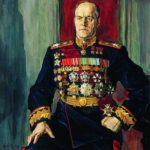Soviet Russian avant-garde artist Pavel Filonov

I.V. Stalin. 1936. Painting by Soviet Russian avant-garde artist Pavel Filonov (January 8, 1883, Moscow – December 3, 1941, Leningrad)
Soviet Russian avant-garde artist Pavel Filonov – a genius of the Soviet avant-garde. The famous, mysterious and largely unknown yet artist and man. December 3, 2018 was exactly 77 years since the day of his death. Filonov died in the most difficult winter of 1941 in Leningrad. Exhausted to the extreme, he guarded his house, and most importantly, his work – the work of all life, from the “lighters” on the icy attic of the house. Once fell down, and the next day he could not get up any more. He died of pneumonia and dystrophy.
What was he like? Tall, big, with “cherry eyes and pale cheekbones …” – wrote a friend of Filonov poet Velimir Khlebnikov, with whom they made friends in 1910. He also told about his friend: “I met an artist and asked if he would go to war. He replied: “I, too, am at war, not for space, but for time. I’m sitting in the trench and taking a scrap of time from the past. My duty is equally heavy, as the troops for space … “.
The people who belonged to the avant-garde were not just people engaged in drawing and painting. They were first of all ascetics, turning everything in their lives into an avant-garde, into an experiment, into a revolution. Their brains, character and even the body were entirely of art. On the avant-gardists Rodchenko and Malevich you can say the same thing. However, in Filonov this all reached its apogee, – says Alexei Kurbanovsky, Ph.D. in Philosophy, chief research officer of the State Russian Museum, which today keeps almost all the works of Pavel Filonov.

1920 painting, untitled
It was in the Russian Museum there was an exhibition in 1988, then in 2006 – a grandiose exposition of the “Eyewitness of the Invisible”, timed to the St. Petersburg International Economic Forum. There was, however, one more, in Soviet times – in 1967 in Novosibirsk. But for many years only specialists were talking about his work, few could see his work. Pavel Filonov, who did not fit in the “right” official art, seemed to have disappeared. But time put everything in its place.

A cow
Now in the permanent exposition of the Russian Museum in the section “XX century” you can see 10 paintings by Pavel Filonov. Such famous ones as “Peasant Family”, “The Living Head”, “Three at the Table”, “Space Formula” and others. The rest of the artist’s works, donated to the museum by his sister, are in the storerooms and waiting for their museum – the “Pavel Filonov’s Museum of Analytical Art”, which he dreamed of all his life.
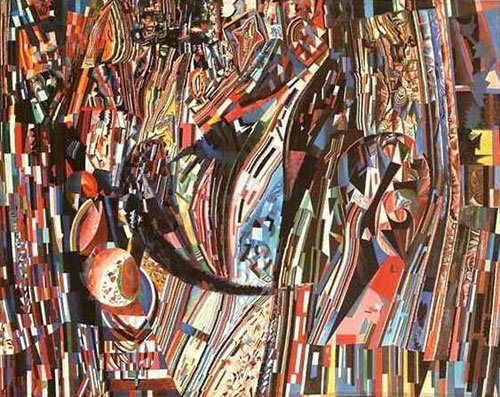
Also untitled
The artist’s paintings travel the country and the world – exhibitions took place both in Russia and abroad. Besides, the study of his heritage continues. Filonov is a deeply original genius, our national heritage. He excites the imagination, showing how much it is possible to transform and expand these very boundaries of the unknown. He poses problems on the border of art, where it begins and on what lines it ends, and this is now the main question in world art.

Animals
Born in Moscow on January 8, 1883, Pavel Filonov orphaned early. Having moved to St. Petersburg, he entered painting shops and afterwards worked “for painting.” In parallel visited evening drawing classes of the Society for the Encouragement of Arts. From 1903 studied in the private workshop of Academician L.E. Dmitriev-Kavkazsky. After completing his studies in a private workshop, Filonov tried to enter the Petersburg Academy of Arts three times. At last, admitted in 1908 as an auditor at the school of the Academy of Arts, he “voluntarily left” it in 1910. “… I took what I needed …”, Filonov explained. He brilliantly studied plastic anatomy. “I know the Latin name of every muscle, every nervous process,” the artist wrote.

At the table (Easter)
For the first time he showed his paintings at the exhibition of the Union of Youth in 1910, where he represented the “Head” series. Next, in 1913, he designed the scenery for Vladimir Mayakovsky’s tragedy. Also, he illustrated futuristic booklets, published his poem “The Prophet about the Sprouted World” and began to develop artistic theories. One of the sensational articles became “Canon and Law”, in which the artist opposed Cubism and Cubo-Futurism. There were a number of exhibitions where his “Feast of Kings”, “Peasant Family” and many others appeared. And in 1919, the artist exhibited his paintings at the first state free exhibition of workers’ art in Petrograd.
Meanwhile, Filonov’s exhibition in the Russian Museum (1929-1930) remained closed shows for a long time.

Attack. 1938
In 1932, instead of all liquidated artistic societies appeared a single Union of Soviet Artists, alien and hostile to Filonov. The artist was accused of creating an art that was incomprehensible, contrary to man. He was out of work, terribly poor, but he continued to draw. Creativity of the artist disappeared from the artistic life of the Soviet country. Political accusations replaced traditional critical responses. The same fate befell and many of his students, which the master had more than a hundred, although there was no special workshop, equipment and materials. An interesting fact – in April 2006, a picture of Pavel Filonov’s apprentice Alisa Poret “Beggars” was sold at Sotheby’s auction for $ 1,472,000.

Bulls. A scene from rural life
According to Filonov, due tpo the lack of orders, there was no a day, that he did not expect any earnings. “On art, I can not make money” (August 2, 1936). Sometimes his stepson Pyotr Serebryakov took work in his name for Filonov. Thus, appeared portraits of Telman, Stalin, Voroshilov for the Seamen’s Club, which Pavel Filonov created.
Pavel Filonov met with Ekaterina Aleksandrovna Serebryakova when he was already about forty. She was 20 years older than the artist. He called her very gently and touchingly – daughter. Ekaterina Alexandrovna faithfully believed in her husband’s talent.
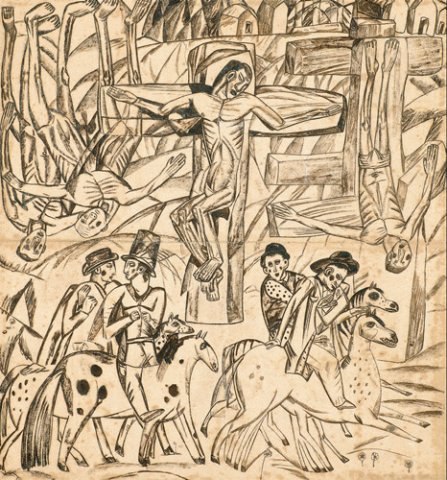
Calvary
Filonov, in defiance of all the schools of the world, who believe that it is necessary to draw from the general to the particular, claimed that it is necessary to do the opposite. Start from anywhere in the picture and go from the private, from the smallest atom, gradually growing, like a tree, like a flower, to the whole. In his technique of analytical painting Filonov insisted that in addition to form and color there is a whole world of invisible phenomena that the “seeing eye” does not see, but the “knowing eye” perceives.

Colonial policy. 1926
Noteworthy, Filonov dreamed of his own museum not out of vanity or self-affirmation, he wanted to make open to the public the new ways of artistic thinking. Supposed that in this museum there will be works of the masters of the Filonov school to show the action and creative results of the analytical method. How could such a museum look like, it was possible to present at the exhibition “Pavel Filonov and his school”, held in Dusseldorf in 1990.

Company
Many times his admirers wanted to buy the works of the master. In particular, Soviet artist Brodsky, who certainly wanted to get at least one of Filonov’s work for his collection. The Tretyakov Gallery also dreamed of replenishing the funds with several drawings of the artist. Filonov did not go to any deals, believing that this would violate the chain of his work sequence.

Composition. 1925
In 1941, Filonov had a paralyzed wife in his arms, nevertheless he did not stop his titanic work. The war began, and with it – night duty on the roof and attic of the house. German “lighters” as peas poured in those first months. And Filonov was on duty in the attic of the house as much as he could.
After the death of the artist, all his work belonged to the younger sister of Evdokia Nikolayevna Glebova. She handed them over to the Russian Museum even during the siege. But immediately after the war the museum returned them to the owner. According to “experts”, Filonov’s works have value only historical, not artistic. The artist’s sister selflessly kept them for many decades. And only in 1977, moving to the House of an actor in old age, she fulfilled the will of her brother – gave to the Russian Museum the whole collection of works of Filonov “without the right to transfer or sell.”
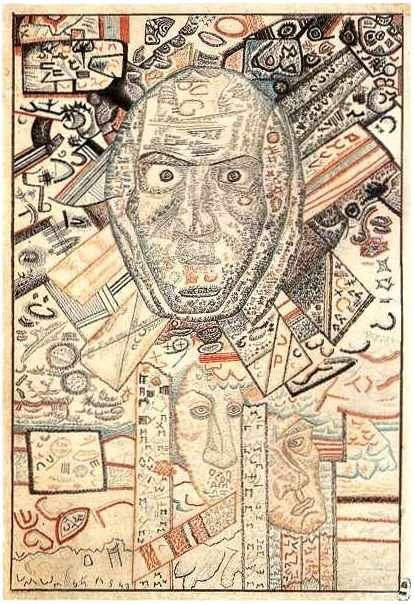
Drawing ‘Head’
However, the state is still in debt to the great master – the Filonov museum still does not exist. The house in Karpovka, where Filonov lived most of his life and where he died, is the best place to build a museum of analytical art,” said Yevgeny Kovtun, a well-known scientist and art historian of the Russian Museum.
Soviet Russian avant-garde artist Pavel Filonov

East and West

Eleven heads

Escape to Egypt

Evolution formula

Faces

Family portrait (Easter). 1924. Paper, watercolor, pencil

Farmer. 1931

French worker

From the untitled pictures of the artist

Geometrical construction

Goat

Head (numbers)
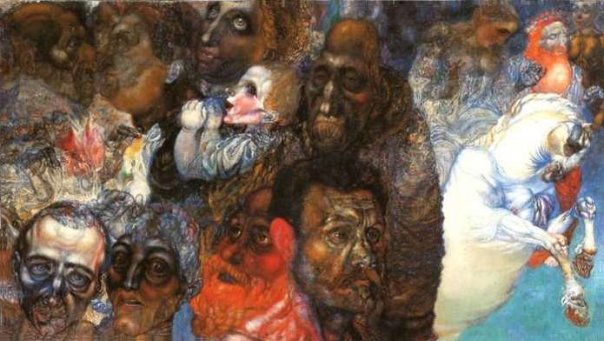
Heads

Hosts. 1913

Houses
Icon of Saint Catherine, 1908-1910. Wood, canvas, tempera

Landscape. Wind. 1907

Living head

Maslenitsa

Mechanic

Milkmaid

Narvi Gate

No title

October. Landscape

Painting ‘Head’

Portrait of A.F. Aziber. 1915. Oil, canvas

Self-portrait. Pavel Filonov

Self-portrait. Pavel Nikolayevich Filonov

Shock workers at the Krasnaya Zarya factory, 1931. Plywood paper, oil

Singer E.N. Glebova portrait

Spring formula
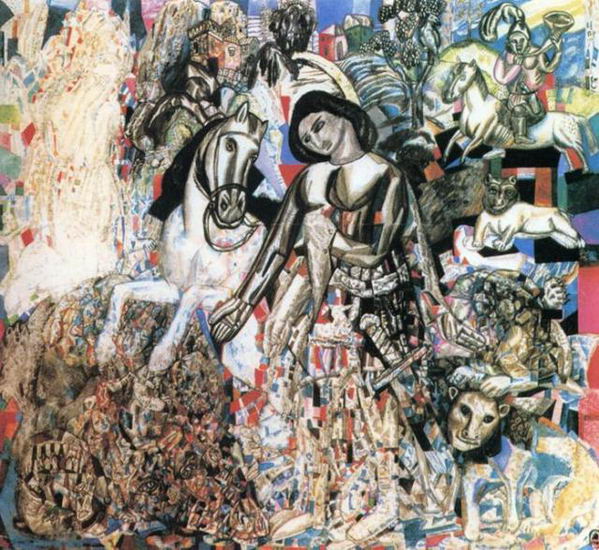
St. George the Winner (untitled)

Symphony of Shostakovich

The cab drivers. 1915

The feast of kings

The revival of a person
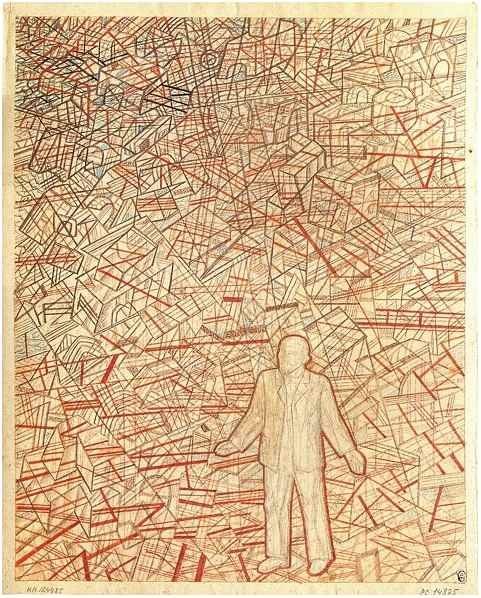
The state plan for electrification of Russia

The virgin with the baby. (Mother)

The wolf pup

Tractor shop. 1930

Two heads

Universe formula

War with Germany

White painting

Worker in a cap. 1930





